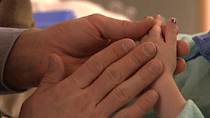
RESOURCES - Leadership Guide
Section 4 - The Series

Remaking American Medicine … Health Care for the 21st Century is ambitious in scope, journeying across the nation to follow an array of pioneering individuals and institutions as they work to bridge the "quality chasm". The series is being produced by Crosskeys Media, the award-winning filmmaking company, and will tell stories of change.
Drawing on unprecedented access to health care institutions across the nation, this four-part series will present detailed and emotionally engaging profiles of individuals struggling to fix our broken health care system. The stories will be told through the eyes of doctors, nurses, administrators and patients, showing their struggles, their setbacks and their victories. The goal is to inspire and empower viewers, both members of the general public and health care professionals, to join in efforts to transform American health care.
Working Titles
Silent Killer
Every year at least 98,000 Americans are killed – and countless more are injured – as a result of medical errors. This program begins by profiling the efforts of Sorrel King, whose 18-month-old daughter died at Johns Hopkins Hospital, one of the most respected health care facilities in the world. King has gone from grieving victim to engaged activist, partnering with Johns Hopkins to make safety a top priority at the institution. Now she has joined forces with Dr. Donald Berwick, a nationally recognized patient safety advocate, to save 100,000 lives in American hospitals.
First Do No Harm
This program focuses on efforts to address medication errors and infections in two hospitals and follows physicians who are challenging their colleagues to live up to their oath to First Do No Harm. In Pittsburgh, Chief of Medicine Dr. Richard Shannon is confronting an epidemic of hospital-acquired infections that are shattering the lives of their victims. In New Jersey, Hackensack University Medical Center is engaged in an effort to transform the way the institution delivers care through the use of cutting-edge information technology. The goal of both efforts is to ensure that the people trusted to provide safe and effective medical treatment do not harm patients.
The Stealth Epidemic
Chronic diseases like diabetes and congestive heart failure affect nearly 100 million Americans, and treatment of these illnesses consumes nearly 70 percent of all health care resources. Yet doctors are often unable to prevent needless suffering or even death, and their failures are threatening the viability of our entire health care system. This program looks at initiatives in two very different communities: Los Angeles and rural Whatcom County in the state of Washington. These groundbreaking efforts are fundamentally transforming the physician-patient relationship and offer a glimmer of hope for those across the country who are struggling with their chronic conditions.
Hand in Hand
As medicine continues to become more and more technologically sophisticated, and the systems that deliver medical care become increasingly complex, the relationship between providers, patients and families is more important than ever. This final program tells the story of patients and families who have formed a unique bond in a teaching hospital in Augusta, Georgia, transforming the institution into a nationally recognized facility where partnership is a guiding vision to the care it delivers.
"Improving the quality of the care hospitals deliver is not a project or a campaign...
it is the fabric and fiber of how doctors, nurses and other caregivers must
approach their work every day, patient by patient. It is creating the kind of
systems that not only changes what is done and how it’s done, but involves patients, families and the community at large. It is work that never ends."
-- Dick Davidson, president
American Hospital Association
>> Previous: Section 3 >> Table of Contents >> Next: Section 5
